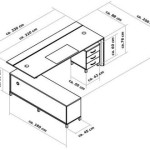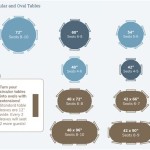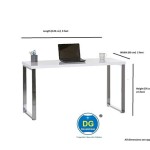Standard Dining Room Table Length: A Comprehensive Guide
The dining room table serves as a focal point for meals, gatherings, and crucial conversations within a home. Selecting the appropriate size is paramount, impacting both functionality and aesthetics. Standard dining room table length directly correlates with seating capacity, room dimensions, and overall comfort. This guide provides a detailed overview of standard dining room table lengths, factors influencing selection, and considerations for optimizing the dining experience.
Understanding standard dimensions provides a baseline for informed decision-making. While customized tables exist, manufacturers typically adhere to established length categories that cater to common household sizes and spatial constraints. These categories generally align with the number of people the table is intended to comfortably accommodate.
Understanding Seating Capacity and Table Length
The most crucial aspect of determining the appropriate dining room table length is the desired seating capacity. Each person generally requires approximately 24 inches of linear space along the table for comfortable eating and movement. This spacing allows for adequate elbow room and prevents guests from feeling cramped.
For a small dining area or households with only two people, a table length of 36 to 48 inches may suffice. This size typically accommodates two to four individuals, depending on the table's width and shape. A round table in this size range can also be a viable option, fostering intimacy and conversation.
A mid-sized dining table, ranging from 60 to 72 inches in length, is suitable for families of four to six people. This length allows for adequate spacing between diners and provides ample surface area for serving dishes and centerpieces. Rectangular tables are a common choice in this size range, offering a practical and versatile design.
For larger families or those who frequently entertain, a dining table length of 78 to 96 inches or even longer may be necessary. These tables can comfortably seat eight to ten people or more, depending on the specific dimensions. Longer tables often require wider rooms to accommodate the extended length and allow for comfortable passage around the table.
It is vital to consider potential future needs when selecting a dining room table length. Choosing a table that can accommodate occasional extra guests, even if it requires slightly more space than currently needed, can prevent the need for a replacement in the near future. Expandable tables, which include leaves that can be added or removed to adjust the table's length, offer a flexible solution for accommodating varying numbers of diners.
Considering Room Dimensions and Spatial Clearance
The available space within the dining room is a crucial factor influencing the maximum acceptable dining room table length. Cramming an oversized table into a small room can create a claustrophobic and uncomfortable dining environment. Adequate clearance around the table is essential for comfortable movement and accessibility.
A general guideline suggests maintaining a minimum of 36 inches of space between the edge of the dining table and any walls or surrounding furniture. This clearance allows individuals to comfortably pull out chairs and move around the table without obstruction. In tighter spaces, 30 inches may be a minimum acceptable clearance, but it may feel somewhat constricted.
Before purchasing a dining table, carefully measure the dimensions of the dining room. Consider the placement of doorways, windows, and other existing furniture. It is advisable to create a scaled drawing of the room and experiment with different table sizes to visualize the spatial impact. Masking tape can be used to outline the dimensions of the proposed table on the floor, providing a tangible sense of the table's footprint.
If the dining room is long and narrow, a rectangular dining table may be the most space-efficient choice. Conversely, a square or round table may be more suitable for a square or more compact dining room. The table's shape should complement the room's overall architecture and maximize the available space.
In open-concept living spaces, the dining area may not be clearly defined by walls. In such cases, it is essential to consider the relationship between the dining area and the adjacent living spaces. The dining table should be scaled appropriately to the overall size of the open-concept area and should not obstruct pathways or visually overwhelm the space.
The Impact of Table Shape and Style on Perceived Length
While the linear measurement of the dining table length is a primary consideration, the table's shape and style can also influence the perceived length and its overall impact on the dining room. Round tables, for instance, tend to occupy a smaller visual footprint compared to rectangular tables of the same seating capacity.
A round dining table encourages conversation and creates a more intimate dining atmosphere. However, round tables can be less efficient for serving large meals, as they lack the linear surface area provided by rectangular tables. Extending round tables, which often have leaves to convert them into oval shapes, offer a compromise between the intimacy of a round table and the functionality of a rectangular table.
Square dining tables work well in square-shaped rooms and can provide a sense of balance and symmetry. However, square tables can be less versatile than rectangular tables and may not be suitable for larger groups. They also limit the ability to add seating on the ends of the table.
The style of the dining table can also affect its perceived length. Tables with slender legs and a minimalist design tend to appear less bulky than tables with thick legs and ornate details. A glass-topped dining table can create a sense of openness and transparency, making the table appear less imposing, even if it is relatively long.
Furthermore, the design of the chairs used with the dining table can influence the overall visual impact. Chairs with low backs and a streamlined profile minimize visual clutter, while chairs with high backs and elaborate upholstery command more attention and can potentially make the table seem smaller in comparison.
The color of the dining table and the surrounding decor also play a role in the perception of length. Light-colored dining tables tend to recede visually, while dark-colored tables stand out more prominently. Coordinating the color of the dining table with the walls and other furniture can create a cohesive and harmonious dining environment, enhancing the overall sense of space.
Ultimately, selecting the appropriate dining room table length requires a careful consideration of seating capacity, room dimensions, table shape, style, and personal preferences. By taking these factors into account, individuals can choose a dining table that not only meets their functional needs but also enhances the aesthetic appeal of their dining room.
Prioritizing both comfort and practicality ensures that the dining room becomes a welcoming and enjoyable space for meals, gatherings, and memorable moments for years to come.

A Guide To Choosing The Ideal Dining Table Width

What Is The Ideal Dining Table And Chair Height

A Guide To Choosing The Ideal Dining Table Width

Dining Table Design Basics Tablelegs Com

What Is The Ideal Dining Table And Chair Height

Standard Dimensions Of Dining Room Layout Floor Area Design

Standard Dining Table Dimensions The Size Guide

Dining Table Dimensions For 4 6 And 8 Seater Tables Flowyline

Standard Dining Table Dimensions And Sizes Designcafe

Table Size Seating Capacity Round Rectangular More
Related Posts








